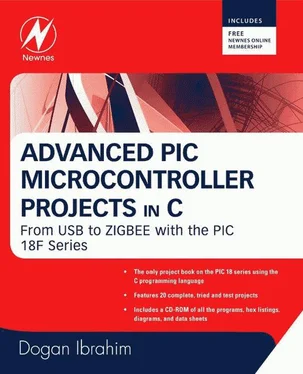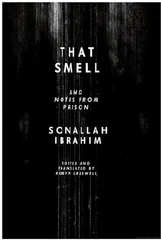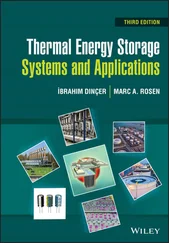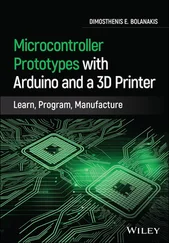********************************************************************/
void main() {
unsigned char j;
double PI = 3.14159, rads;
for(j = 0; j <= 90; j++) {
rads = j * PI /180.0;
angle = sin(rad);
Trig_Sine[j] = angle;
}
}

Figure 4.27: Calculating the sine of angles 0 to 90
String Library
The functions in the String library are used to perform string and memory manipulation operations. Table 4.9 lists the commonly used functions in this library.
Table 4.9: Commonly used String library functions
| Function |
Description |
| strcat, strncat |
Append two strings |
| strchr, strpbrk |
Locate the first occurrence of a character in a string |
| strcmp, strncmp |
Compare two strings |
| strcpy, strncpy |
Copy one string into another one |
| strlen |
Return the length of a string |
Example 4.17
Write a program to illustrate how the two strings “MY POWERFUL” and “COMPUTER” can be joined into a new string using String library functions.
Solution 4.17
The required program listing is shown in Figure 4.28 (program JOIN.C). The mikroC String library function strcat is used to join the two strings pointed to by p1 and p2 into a new string stored in a character array called New_String .
/******************************************************************
JOINING TWO STRINGS
===================
This program shows how two strings can be joined to obtain a new string.
mikroC library function strcat is used to join the two strings pointed to by
p1 and p2 into a new string stored in character array New_String.
Programmer: Dogan Ibrahim
File: JOIN.C
Date: May, 2007
*******************************************************************/
void main() {
const char *p1 = "MY POWERFUL "; // First string
const char *p2 = "COMPUTER"; // Second string
char New_String[80];
strcat(strcat(New_String, p1), p2); // join the two strings
}

Figure 4.28: Joining two strings using function strcat
4.3.7 Miscellaneous Library
The functions in the Miscellaneous library include routines to convert data from one type to another type, as well as to perform some trigonometric functions. Table 4.10 lists the commonly used functions in this library.
Table 4.10: Commonly used Miscellaneous library functions
| Function |
Description |
| ByteToStr |
Convert a byte into string |
| ShortToStr |
Convert a short into string |
| WordToStr |
Convert an unsigned word into string |
| IntToStr |
Convert an integer into string |
| LongToStr |
Convert a long into string |
| FloatToStr |
Convert a float into string |
| Bcd2Dec |
Convert a BCD number into decimal |
| Dec2Bcd |
Convert a decimal number into BCD |
The following general programs illustrate the use of various library routines available with the mikroC language.
Example 4.18
Write a function to convert the string pointed to by p into lowercase or uppercase, depending on the value of a mode parameter passed to the function. If the mode parameter is nonzero, then convert to lowercase, otherwise convert it to uppercase. The function should return a pointer to the converted string.
Solution 4.18
The required program listing is given in Figure 4.29 (program CASE.C). The program checks the value of the mode parameter, and if this parameter is nonzero the string is converted to lowercase by calling function ToLower , otherwise the function ToUpper is called to convert the string to uppercase. The program returns a pointer to the converted string.
/*********************************************************************
CONVERT A STRING TO LOWER/UPPERCASE
=====================================
This program receives a string pointer and a mode parameter. If the mode is 1
then the string is converted to lowercase, otherwise the string is converted
to uppercase.
Programmer: Dogan Ibrahim
File: CASE.C
Date: May, 2007
***********************************************************************/
unsigned char *Str_Convert(unsigned char *p, unsigned char mode) {
unsigned char *ptr = p;
if (mode != 0) {
while (*p != '\0') *p++ = ToLower(*p);
} else {
while (*p != '\0') *p++ = ToUpper(*p);
}
return ptr;
}

Figure 4.29: Program for Example 4.18
Example 4.19
Write a program to define a complex number structure, then write functions to add and subtract two complex numbers. Show how you can use these functions in a main program.
Solution 4.19
Figure 4.30 shows the required program listing (program COMPLEX.C). At the beginning of the program, a data type called complex is created as a structure having a real part and an imaginary part. A function called Add is then defined to add two complex numbers and return the sum as a complex number. Similarly, the function Subtract is defined to subtract two complex numbers and return the result as a complex number. The main program uses two complex numbers, a and b, where,
a = 2.0 – 3.0j
b = 2.5 + 2.0j
/*************************************************************
COMPLEX NUMBER ADDITION AND SUBTRACTION
===========================================
This program creates a data structure called complex having a real part and
an imaginary part. Then, functions are defined to add or subtract two complex
numbers and store the result in another complex number.
The first complex number is, a = 2.0 – 2.0j
The second complex number is, b = 2.5 + 2.0j
The program calculates, c = a + b
and, d = a − b
Programmer: Dogan Ibrahim
File: COMPLEX.C
Date: May, 2007
***************************************************************/
/* Define a new data type called complex */
typedef struct {
float real;
float imag;
} complex;
/* Define a function to add two complex numbers and return the result as
a complex number */
complex Add(complex i, complex j) {
complex z;
z.real = i.real + j.real;
z.imag = i.imag + j.imag;
Читать дальше













